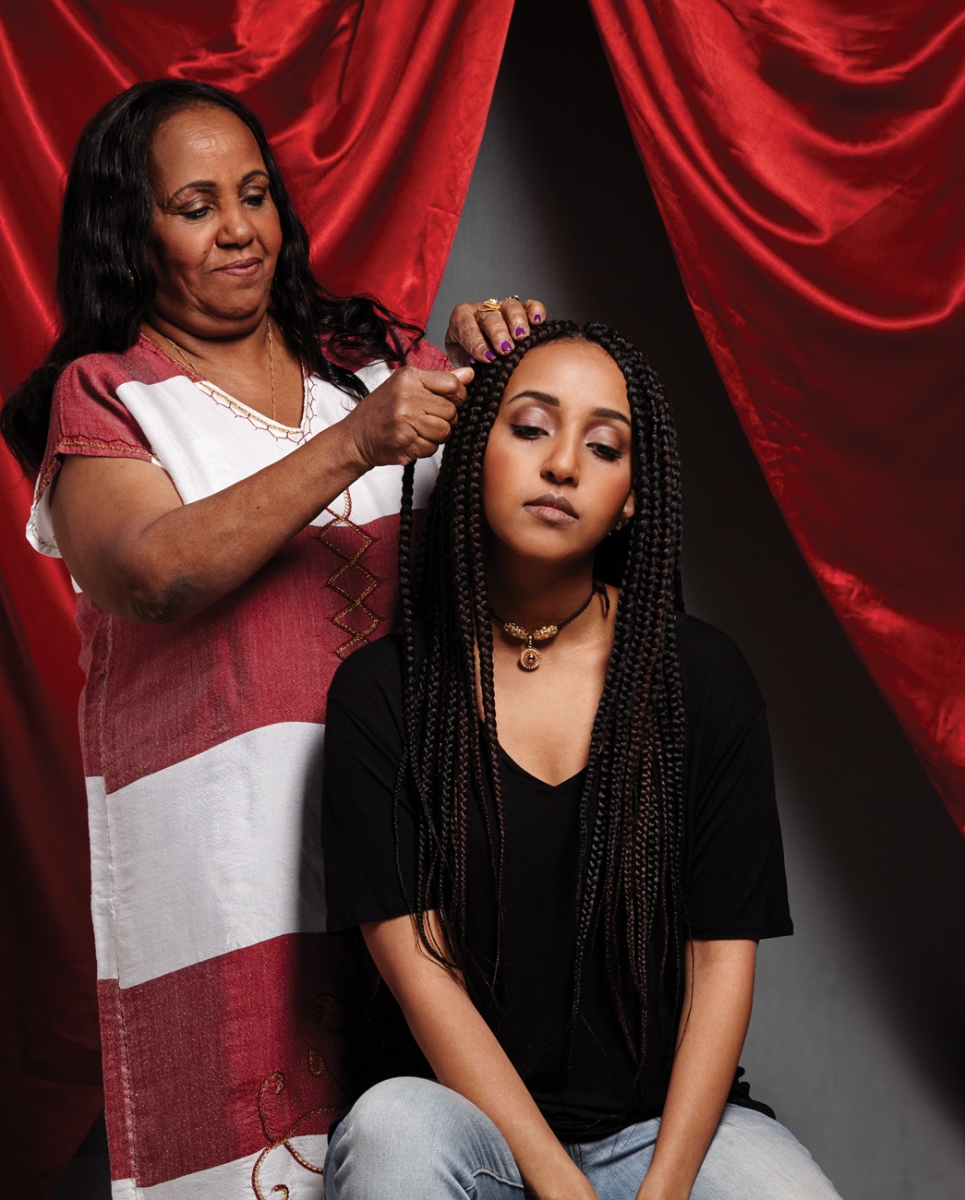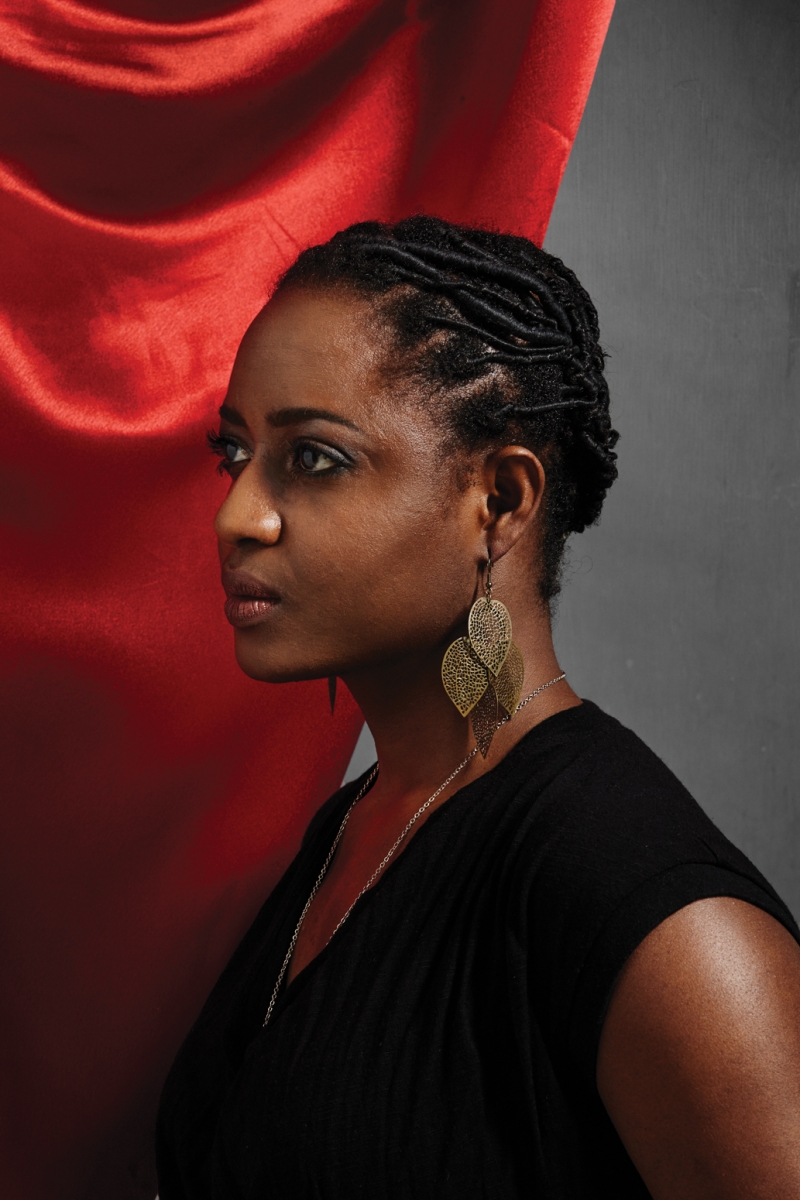
There they were: The bubbly models in the Pantene commercials flipped their hair in slow motion while they smiled into the camera, the obligatory comb glided seamlessly through their tresses like fingers through water.
And there I was: A scrawny child wincing in a hard plastic chair in the living room of our small apartment, while my mother braided the dense forest that was my hair. I’d sit there and watch them sell me their beauty between episodes of Mike Sobel’s Disney Afternoon, occasionally breaking my attention to challenge the giant Jesus rug on the wall to a staring contest; he won every time. I wanted nothing more back then than to be able to flip my hair around like the women in those commercials without worrying about catching a braid in the eye.
But that chair. I hated that chair. In my simple little child mind, every time my mom would pull that thing out, I felt like I was minutes away from a punishment of detangling and blow drying, followed by hours of tedious braiding; looking back it was probably worse for my mother who luckily has the patience of a saint. My ass would go numb about an hour in, as I squirmed around the grooves of this cheap little plastic chair, but, for years, this was all I knew. This was normal.
My hair – even as a child- has always been the cause of some interesting attention: Random fingers making their way through my coils, their owners astonished at my hair’s texture and wondering how often I wash it; the fact that my hygiene has so consistently come into question throughout the years speaks volumes about how certain Black hairstyles are perceived. Dreads, braids, afros, twists; I don’t know any that haven’t, at one point or another, felt a hand creep in there and cop a feel. And, no, smiling while you do it doesn’t help the situation either.
Recently, I walked into the familiar terrain of my go-to Black beauty shop with fellow writer, Gloria Alamrew, and we began to navigate the aisles for our necessities. The shop was lined with a seemingly endless supply of products and tools that are often reserved to a miniscule section at local department and drugstore beauty aisles. As we made our way down the rows, between the assortment of oils and bundles of hair, our conversation turned to stories about our own struggles trying to get our hair done in Edmonton. “My parents have been here almost 30 years,” said Gloria, “and my mom had the same struggles when they first got here that I’m having now.”

I’d only later grasp how much my mother’s own understanding of my hair wouldn’t necessarily translate among many salon employees in Edmonton. She is a self-taught Eritrean woman, and I am her only daughter. She tried her best to nurture and care for my hair without the privilege of a cosmetology education, guided by her love for me and knowing that, with hair like mine, there was really no other option. All things considered, she had a pretty soft touch too; something I went on to appreciate later once other hands had their way with my scalp.
Throughout the years, the chair has changed. The locations have changed. The experiences however have – for the most part – teetered on the same: Trying to find trusted stylists in Edmonton salons who have a thorough understanding of Black hair continues to be a rite of passage for many of us, and, in numerous instances, finding “the one” can mean you’re compromising in some way.
Gloria recalled a time not too long ago when she booked an appointment at a local salon for a wash, cut and style.
“This place has two locations, and I called [one of them] and specifically asked ‘Do you do natural, Black, African, curly, thick hair?'” The salon employee assured her that it did, but, when she arrived for her appointment she was asked to have a seat while the stylist rushed to make a phone call.
“I see them calling the other salon and I hear her saying that my hair is really thick and really curly and that [she] doesn’t think there’s anyone here that can do it.” They would go on to try and smooth over the situation by explaining that there was only one stylist at the other location that was trained to properly do Black hair, but that she wasn’t in that day.
Call around to some popular salons in the city, and you’ll most likely get referred to a single stylist at each location that is properly trained – and comfortable – doing our hair, while the occasional salon will flat out state it can’t do it at all. The stylists that step up to the plate are usually the ones that have taken some initiative to learn on their own, although sometimes their claims are just that, and it ends up being as much of a failure as being turned away altogether.

I remember my first salon experience. I was around eight or nine, I think, and my parents decided to let me get my hair done by a “professional” for my birthday. I don’t think I can express the excitement I felt walking to that tiny, unassuming salon in the old Zellers in Kingsway Mall, tucked away beside the pharmacy and down the aisle from the snack food and feminine hygiene products. I remember the defeated look on the elderly white lady’s face as I sat in the chair and unraveled my hair; I knew, even at that age, that she was questioning her life decisions at that point. My dream of walking out with hair like one of the Pantene models was crushed; I left looking like I got electrocuted on my way to sell Mary Kay cosmetics circa 1982. For the first time, but not the last, I was missing my mother’s chair. But not for long. I was back in the cheap plastic chair the very next day, fidgeting and wincing while my mom fixed it back to my signature do; braids with a small, perfectly cylindrical bang that would confidently sit atop my large east African forehead. Tradition can become a necessity when the other options won’t do.
In the United States, the Black hair industry will reach $761 million by 2017 according to data collected by market intelligence agency, Mintel. So where exactly does the problem lie? How is it that a demographic that contributes so much to the beauty industry continues to have such a difficult time, and why aren’t all local salons fully capable of catering to this market?
Education, in this instance, is key. Anna Gemellaro, Director of Education at MC College, one of Edmonton’s beauty schools, emphasizes that her school teaches all hair types, but admits that there isn’t a whole lot of focus on black hair in particular due to few clientele. While the school does teach students how to apply extensions and relax hair, she says their biggest problem lies with what she sees as not having a high enough demand for it.
“We don’t have a lot of experience, because we don’t get a whole lot of customers to practise on. We haven’t had the demand.” She adds, “Once a customer comes in [the students] know what to do, but I wish we had more of a clientele so they could practise more; they are inexperienced [with it] because they don’t have the clientele.”
And while Hibo George, a graduate of EvelineCharles Academy, values the education that she did receive for teaching her some fundamentals, she agrees that students should take the initiative to further their education outside of the classroom as much as they can. She believes there is a void by not including modules specifically teaching Black hair in schools.
“Of course, it would be helpful for everybody. We are very [multicultural] here and if you walk into a salon and wanted something done [the stylist] should be saying ‘yes’ not ‘no, I don’t do this,’ but a lot of salons do that unfortunately.”
She adds, “I have to get myself out there so I can learn as much as I can. There’s [always] more to learn, it just depends on how much you want it.” Osas Eweka, black hair advocate and founder of Nappy Roots Beauty Edmonton, a natural hair community, felt that void and launched the Edmonton Natural Hair Show back in April 2016, and then followed with a flagship event in Halifax the following October. The events became a hub for women of different backgrounds in those respective cities to share ideas, stories and learn more about their hair from the science of what makes it different, to the ever politicized nature of natural Black hair in mainstream society.
“My challenge for these salons and schools is to try to be more inclusive of the Black community in terms of the products they carry in their stores and also in hiring people who actually know how to do Black hair. It shouldn’t have to be that hard.” She adds, “It’s the responsibility of these places to train their staff [and for the profitable ones] to maybe send them to the U.S, where the market is much larger.”
Through this void, Black women have created an unofficial network, almost subconsciously, referring stylists – including unlicensed ones working from home – to help us find the right people for our respective hair needs. The rise of YouTube vloggers and their tutorials have also encouraged more women to take matters into their own hands but, in the end, the route we take ultimately comes down to comfort.
After our visit to the Black hair shop, Gloria and I parted ways and I went back home to prep my hair for the next day; my neighbour occasionally does hair from home and was going to give me braids, a much needed break for me. The style that I pushed away for so long is one that I have come back to embracing again over the last few years, and has ultimately brought me back to a familiar place; in the living room of a self-taught Eritrean woman, wincing in a chair and staring off into space waiting for the hours to go by a little faster.
Brnesh Berhe is a graphic designer, illustrator, and writer in Edmonton, and is currently the Art Director at The Yards Magazine.Follow Berhe on Instagram.








